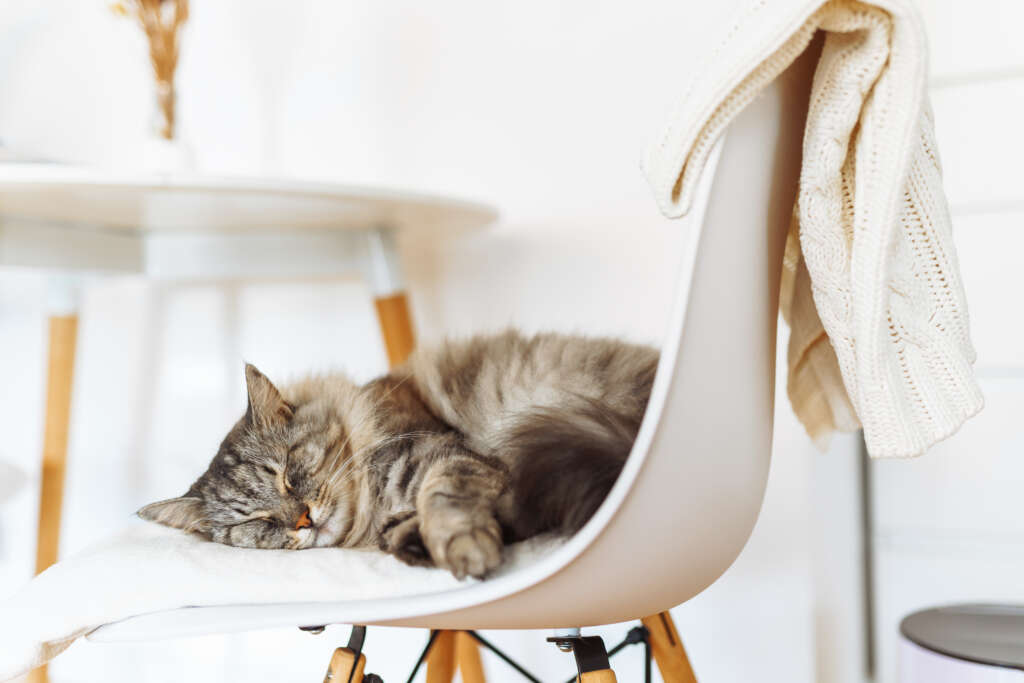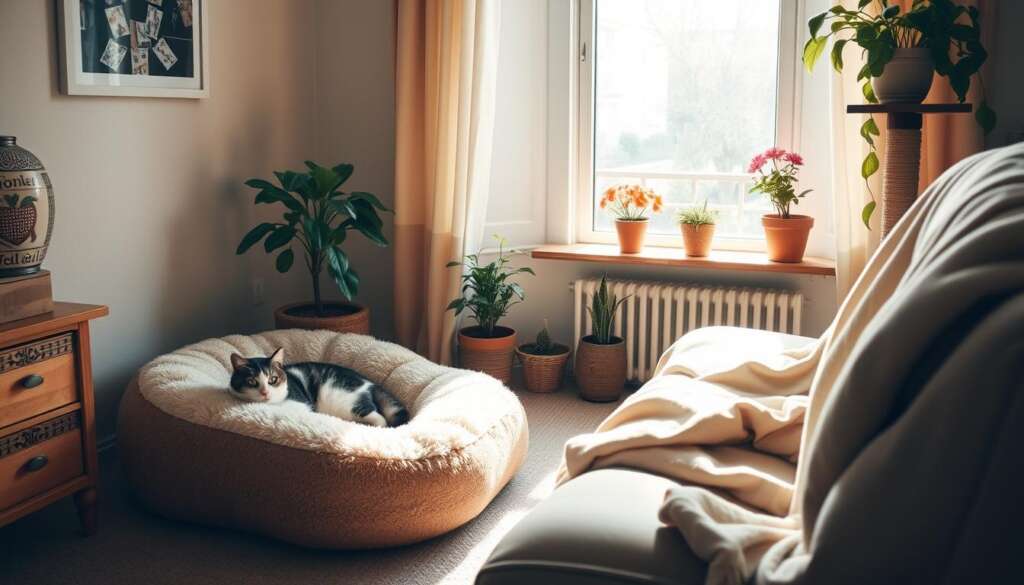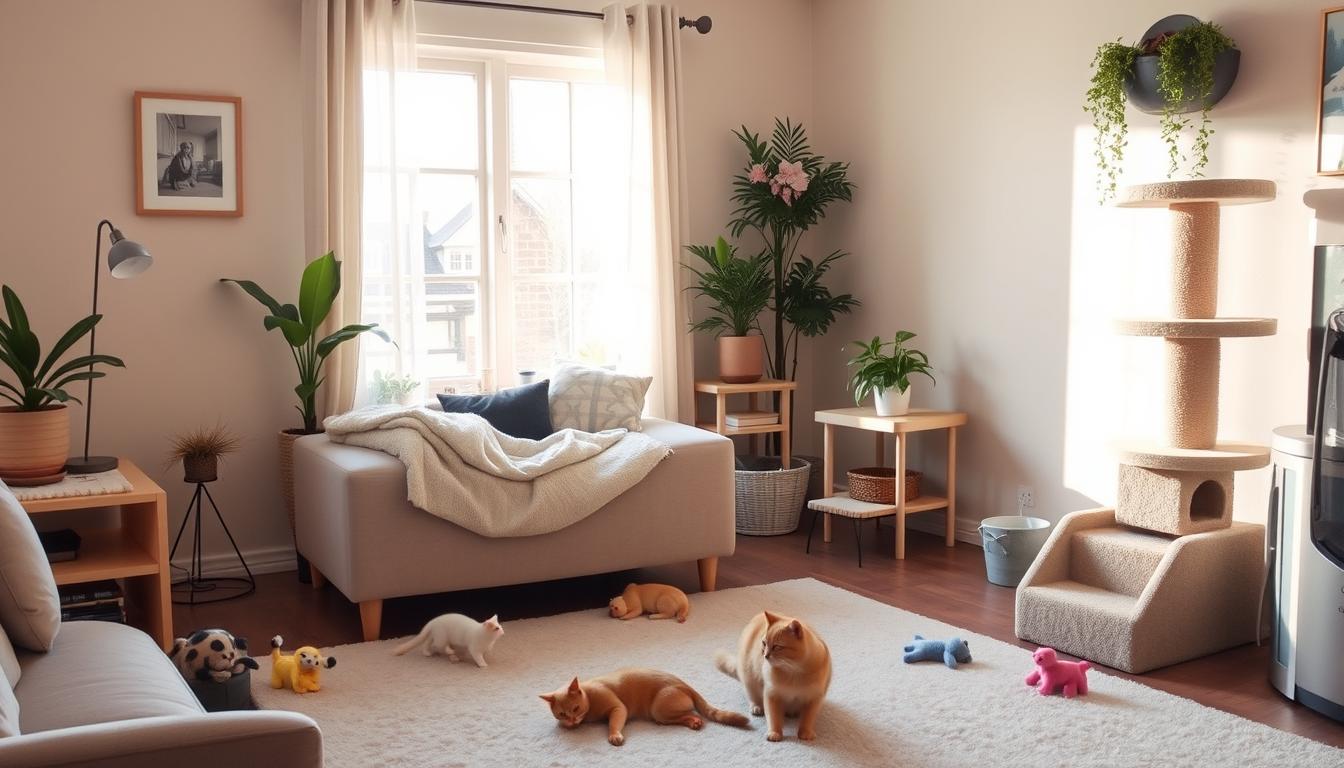Share This Article
As our cats grow older, their needs change. It’s not just about showing love; it’s about creating a comfortable environment for older cats. This is crucial as they age.
Our cats may not talk, but their needs are clear as they get older. They might face health issues like arthritis and vision loss. This makes it important to create a senior pet space that’s safe and comfy.
How do we know if our cats are happy and healthy? What changes can we make to help them? Katie Grzyb, DVM, has some answers. She suggests making spaces easier to move around in and finding favorite spots.
Senior cats hold a special place in our hearts. They are filled with memories and love. Creating a space that meets their needs is a way to celebrate their lives and our bond with them. Let’s see how we can honor their golden years.
Understanding the Unique Needs of Aged Felines
As cats get older, around 8 years, they need a special senior cat home environment. This environment should support their health and happiness. Cats in their senior years, from 10 to 14, and super seniors over 15, have different health needs.
Creating an elderly cat-friendly home means adapting to their physical and health changes. For example, older cats often have arthritis and need comfy places to rest. They also need regular vet visits to check their health.
Dental disease is common in older cats, so they need good oral care. Their diet changes with age, so feeding them small meals often helps. They also sleep a lot, so a warm and quiet place to sleep is key in a senior cat home environment.
Watching for changes in behavior is important. Senior cats might vocalize more or groom less. Helping them with grooming keeps their coat healthy. Also, making sure food, water, and litter are easy to reach helps them stay independent in their elderly cat-friendly home.

Cognitive health is just as important as physical health. Engaging play and stimulation help keep their minds sharp. Each care step helps make their golden years comfortable and loving.
Redefining Navigation and Accessibility
Making a home comfortable for aging cats means making smart changes. Ramps or cat stairs help them get to their favorite spots safely. This is good for their joints. About 65% of cat owners say elevated spots make their senior cats more relaxed.

Adding tips for a senior cat-friendly home makes a big difference. Make sure food, water, and cozy spots are easy to reach. This boosts a senior cat’s life quality a lot.
Changing your home layout to fit your cat’s needs is key. Night lights help cats see better, especially at night. This makes them feel safer.
Choosing the right litter box is also important. About 60% of senior cats prefer easy-to-reach litter boxes. This keeps them comfortable and clean. Making a home comfortable for aging cats is more than just physical help. It’s also about keeping things stable and familiar to reduce stress.
Regular vet visits and gentle play are important. Keeping their area warm and draft-free is also crucial. Older cats get cold easily.
Comfortable Home for Senior Cats: A Guide to Essential Adjustments
Creating a special space for senior cats is key to their happiness and health. As cats get older, they face physical and mental changes. These changes can affect their daily life. So, making your home comfortable for older cats is important.

Start by focusing on bedding. Senior cats love beds with extra padding or a warm element. This helps with sore joints and muscles. Place these beds in quiet, sunny spots for the best comfort.
Many senior cats struggle with jumping and climbing. To help, use step stools, ramps, or pet steps. These make it easier for them to get to their favorite spots. It also keeps them safe from falls.
For feeding, use raised cat bowls. This helps older cats eat and drink without straining. It’s especially good for cats with arthritis. Also, watch their food and water intake closely. Changes can signal health problems.
Adjusting our homes for our aging cats shows we value their companionship. It improves their life in their golden years. This care supports their health and spirit.
Don’t forget regular vet visits. Senior cats should see the vet every six months. Early detection of health issues like kidney disease or diabetes is crucial. It helps keep your cat happy and healthy.
Caring for a senior cat is more than just love. It’s about creating a safe, welcoming space tailored to their needs.
Nutritional Considerations and Feeding Solutions
As cats get older, their diet needs change. This makes senior cat comfort very important. It’s key to meet these changes to keep them healthy and happy.
Keeping them hydrated is crucial. Older cats might not drink enough water, which can lead to kidney disease. Using easy-to-reach water bowls and adding wet food can help.
Senior cats need fewer calories but more protein. This helps them stay at a healthy weight and keep their muscles strong. Sometimes, vets suggest special diets for them.
Feeding areas should be comfortable for seniors. Use shallow, wide bowls that are easy on their whiskers. Place them in quiet spots where your cat can eat without stress.
Regular vet visits are important. They can give advice on the best food for your cat’s health. This ensures your cat gets the right nutrition, making your home senior cat-friendly.
By following these tips for a senior cat-friendly home, you create a caring space. Good nutrition, easy access to water, and a comfy eating area all help your senior cat stay healthy and happy.
Senior Cat Bathroom Habits and Litter Box Modifications
As cats get older, usually from 12 to 14 years, their home needs to change. This includes their bathroom habits and litter box setup. It’s key to make their home comfortable as they age.
Dr. Levine suggests placing litter boxes on every floor for cats with arthritis or bladder issues. The right litter box setup can greatly improve a senior cat’s life. For example, the KittyGoHere Senior Cat Litter Box and the Van Ness Large Framed Cat Litter Pan are great options. They have low entry points to prevent strain.
It’s also important to have multiple litter boxes in a senior cat’s home. This reduces stress and makes it easier for them to find a spot to go. Quiet, easy-to-reach locations are best to avoid accidents.
Modifying litter boxes can also help. For example, the Booda Dome Cleanstep Litter Box has a ramp for easy access. Soft, unscented litter is also recommended for sensitive paws and noses.
Watching how a senior cat uses the litter box can tell you a lot about their health. Avoiding the litter box or changes in urine output might mean they have a health issue. Keeping the litter box clean and regular cleaning schedules help keep them comfortable.
In short, making a senior cat’s litter area friendly is crucial. It involves careful planning, from the number of boxes to their types and where they are placed. This is all about meeting the physical and health needs of older cats.
Stimulating the Mind of Your Senior Cat
To keep your home exciting for an older pet, it’s key to know the right tips for a senior cat-friendly home. Keeping their mind sharp helps prevent cognitive decline and keeps their life quality high. Using toys that fit their age and adjusting playtime to their abilities makes a big difference.
Puzzle feeders are great for keeping their mind active. They challenge problem-solving and offer a reward. There are many designs to fit different skill levels, ensuring your senior cat stays engaged without getting frustrated. These feeders tap into their natural hunting instincts, making them a great fit for an elderly cat-friendly home.
It’s also important to match playtime to your senior cat’s energy and physical state. Some cats tire easily, so shorter, more frequent play sessions are better. Adding catnip and silvervine can also help; they make your cat feel happy and relaxed, which is good for seniors.
Regular play also strengthens your bond with your pet. It builds trust and companionship, just as important as a physical environment in a senior cat-friendly home.
Lastly, always share your cat’s behavior and health with your vet during check-ups. Their advice is crucial in making your home and routines better for your senior cat’s well-being and happiness.
Celebrating the Senior Years with Your Feline Companion
Caring for our feline friends as they age is both delicate and rewarding. Cats enter their senior years around age 7. During this time, we need to tailor their care for their senior cat comfort. Creating a comfortable environment for older cats goes beyond physical changes like litter boxes or quiet spots. It’s about building a deeper bond through patience, understanding, and love.
It’s crucial to watch for signs of discomfort or disease in senior cats. Dental issues, common in older cats, can greatly impact their happiness. We must feed them foods high in Omega-3 fatty acids and antioxidants to support their aging bodies. Regular vet visits are also key for catching and managing conditions like arthritis early.
Senior cats find comfort in routine and familiarity. As they age, our role changes to meet their evolving needs with love and reassurance. By making their living space comfortable and staying on top of their health, we create a nurturing environment. Let’s also remember to cherish the joy of sharing life with our senior cats, making every moment special.


